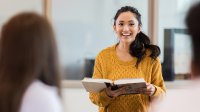How Literature Can Enhance Math and Science
Teachers can use stories and poems to boost students’ understanding of math and science concepts while giving them extra reading practice.
Your content has been saved!
Go to My Saved Content.Many of my students are surprised by how much I love to read. I hear, “But you’re the math and science teacher!” and “Why don’t you just teach reading?” I always explain that the way we divide subjects in school doesn’t exist in the real world. In everyday life, we don’t separate our time into short blocks to focus on one set of skills, so why do we do this in school? Here are three ways I incorporate reading into elementary science and math classes.
Reading Across the Curriculum
1. Readers’ theater: When my class nears the end of our human body unit in science, we perform a readers’ theater titled I Am the Most Important: A Script About the Human Body Systems, by Amy Bowden. I put on a makeshift judge’s robe, I pass out scripts, and my students act out the parts of the human body systems, each arguing their case that they are the most important.
Not only are students reviewing what they’ve learned about the functions of human body systems, but also they are practicing fluency and comprehension. This inspires many students to pick readers’ theater to present projects. They write entire scripts for their classmates to perform and get excited about including others in what they have learned. This enthusiasm helps them naturally dig deeper into topics we’re studying.
2. Poetry: Every year, I begin my solar system unit with a poem: “A Lonely Planet Ponders,” by John P. Curtin. After analyzing it, we begin discussing planets and galaxies. I’ve found that when my students begin with poetry analysis, it helps them enter a headspace that is conducive to discussing abstract concepts. They are more willing to ask big questions about a topic that is naturally interesting to them.
Throughout this unit, students write poems to describe characteristics of planets and demonstrate their knowledge by using descriptive imagery. In addition to abstract concepts, my students enjoy using poetry to understand the cycles that we study in science. Students write poems to creatively describe the steps in a process. Poetry works particularly well in upper elementary grades.
3. Read-alouds and storytelling: Many students walk into our math classrooms feeling nervous about doing math. By using read-alouds and storytelling, we can not only encourage students to have a growth mindset but also help them make sense of problems. One book I love reading aloud is The Girl Who Never Made Mistakes, by Mark Pett and Gary Rubinstein. Reminding students (especially my students who are gifted) that mistakes are an important part of the learning process can help them feel more comfortable taking risks during math.
When students are struggling with a particular concept, I enjoy turning it into a storytelling experience. My students find success when they can ground abstract concepts in reality. Whether this is creating stories about my students and sharing or asking them to come up with scenarios in which we would use a particular skill, we are able to grow as learners and express creativity simultaneously.
For example, dividing and fractions can be tough for students to grasp. We can come up with a story about our class ordering pizza for lunch. If there are 20 students in the class and we have three pizzas that are cut into eight slices each, and we do not want leftovers, how do we split up the pizza? What fraction of a whole pizza does each person get? Whenever possible, we create stories about our class or specific students and use our math skills to solve problems in sharing situations.
I also enjoy reading longer novels to students when I can tie them to a topic or project. When my students are learning fractions, I always like to incorporate novels where kids are baking or cooking (the All Four Stars series, by Tara Dairman, and From the Desk of Zoe Washington, by Janae Marks, are two of my favorites). In addition to listening to a story, students could create a class cookbook or complete a project.
For example, in From the Desk of Zoe Washington, Zoe tries out several cupcake recipes and adjusts how much of each ingredient she uses. She tastes each batch to see which ones are best. By replicating this in the classroom, students not only learn more about using fractions in real life but also explore chemical changes.
Literature is great in science classrooms as well. A resource I use in science is Everyday Science Mysteries, by Richard Konieck-Moran. Each lesson in this series starts with a story and includes an inquiry activity that can be used in the science classroom. The book also includes ways to adapt the lessons for different learners.
Students constantly ask, “Why do we need to know this?” and that question can be easily answered if we can show how what we do in the classroom relates to the real world. Some math and science teachers are (understandably) apprehensive about teaching reading. However, some schools are moving to a reading curriculum that focuses more on building background knowledge than explicitly teaching reading strategies in isolation. When we use varieties of texts in math and science, our students’ reading comprehension will improve simply because of the practice.
